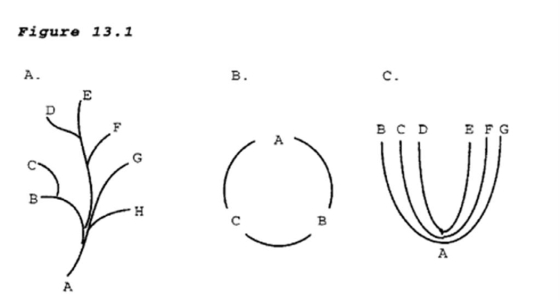A) the wing of a bird and the wing of a bee
B) the wing of a bee and the wing of a bat
C) the wing of a bat and the wing of a bird
D) All of these answers are correct.
Correct Answer

verified
Correct Answer
verified
Multiple Choice
Structures that are similar in different species and have a common ancestor are
A) analogous.
B) related.
C) revolutionary.
D) homologous.
Correct Answer

verified
Correct Answer
verified
Multiple Choice
In the process of speciation, a type of barrier between organisms is
A) hybridization.
B) mutation rate.
C) habitat preference.
D) All of these answers are true.
Correct Answer

verified
Correct Answer
verified
Multiple Choice
If the embryos of a mating do not develop properly and die, thus preventing the offspring of two different species from continuing to reproduce, they are an example of
A) behavioral isolating mechanisms.
B) mechanical isolating mechanisms.
C) biochemical isolating mechanisms.
D) hybrid inviability.
Correct Answer

verified
D
Correct Answer
verified
Multiple Choice
Animal A can breed with animal D and produce a fertile offspring, animal C. If animal A breeds with animal B, they have a sterile offspring, animal E. The animals that belong to the same species are
A) A and E.
B) A and B.
C) A and C.
D) B and E.
Correct Answer

verified
Correct Answer
verified
Multiple Choice
Which of the following would be homologous structures?
A) the wing of a bird and the wing of a bee
B) the wing of a bee and the wing of a bat
C) the wing of a bat and the arm of a human
D) All of these answers are correct.
Correct Answer

verified
Correct Answer
verified
Multiple Choice
In the figure, the pattern of divergent evolution is best illustrated by 
A) A.
B) B.
C) C.
D) None is a good illustration of divergent evolution.
Correct Answer

verified
Correct Answer
verified
Multiple Choice
The several species of finches that developed on the group of islands in the Galápagos are an example of
A) convergent evolution.
B) adaptive radiation.
C) divergent evolution.
D) polyploidy.
Correct Answer

verified
Correct Answer
verified
Multiple Choice
The theory that evolution occurred slowly and that changes accumulate over long time periods is
A) gradualism.
B) punctuated equilibrium.
C) convergent evolution.
D) divergent evolution.
Correct Answer

verified
Correct Answer
verified
Multiple Choice
A geographic barrier
A) is an isolating mechanism.
B) can stop gene flow.
C) is important for speciation to take place.
D) All of these answers are true.
Correct Answer

verified
D
Correct Answer
verified
Multiple Choice
The courtship rituals of many related animals are highly species-specific and prevent the related species from mating. This is an example of
A) habitat preference.
B) ecological isolation.
C) seasonal isolation.
D) behavioral isolation.
Correct Answer

verified
Correct Answer
verified
Multiple Choice
Which of the following is not a piece of evidence that supports the theory of evolution?
A) Changes in the genetic makeup of an individual organism have no influence on evolution.
B) Different populations of the same species show adaptations suitable for their local conditions.
C) Changes in the characteristics displayed by species can be linked to environmental changes.
D) Selective breeding of domesticated plants and animals indicates that the shape, color, behavior, metabolism, etc., of organisms can be selected for.
Correct Answer

verified
A
Correct Answer
verified
Multiple Choice
The idea that evolution occurs in spurts of rapid change followed by long periods of little change is
A) gradualism.
B) convergent evolution.
C) differential reproduction.
D) punctuated equilibrium.
Correct Answer

verified
Correct Answer
verified
Multiple Choice
Two animals can mate and produce fertile offspring if they are members of different
A) species.
B) subspecies.
C) orders.
D) None of these answers is true.
Correct Answer

verified
Correct Answer
verified
Multiple Choice
Which is true?
A) Neandertals were probably a different species from other early humans.
B) Neandertals and Homo erectus were the same genus.
C) Australopithecus was first discovered in Central America.
D) Several species of Neandertals were discovered in Europe.
Correct Answer

verified
Correct Answer
verified
Multiple Choice
Which of the following would constitute a species?
A) all the birds that live in Michigan
B) all the mallard ducks in the world
C) you as an individual
D) the weeds in your yard
Correct Answer

verified
Correct Answer
verified
Multiple Choice
Geographic isolation prevents
A) continental drift.
B) mating.
C) mutations.
D) polygenic inheritance.
Correct Answer

verified
Correct Answer
verified
Multiple Choice
The idea that species can remain unchanged for millions of years and then rapidly evolve within a short time is
A) adaptive radiation.
B) convergent evolution.
C) punctuated equilibrium.
D) gradualism.
Correct Answer

verified
Correct Answer
verified
Multiple Choice
The genes you inherited from your parents are an example of
A) speciation.
B) evolution.
C) adaptive radiation.
D) gene flow.
Correct Answer

verified
Correct Answer
verified
Multiple Choice
Adaptive radiation results in which of the following?
A) extinction in many cases
B) a divergence of body form and function
C) convergent evolution, for most cases
D) an increase in the amount of competition
Correct Answer

verified
Correct Answer
verified
Showing 1 - 20 of 58
Related Exams